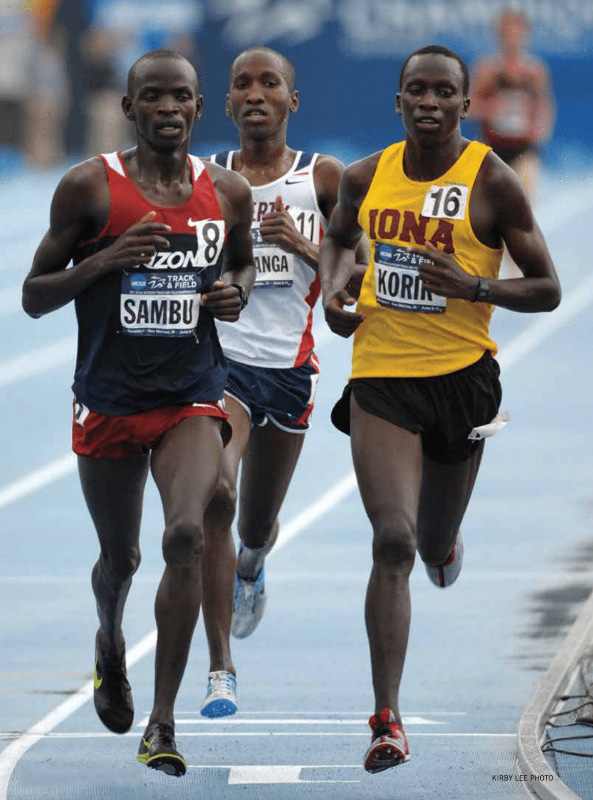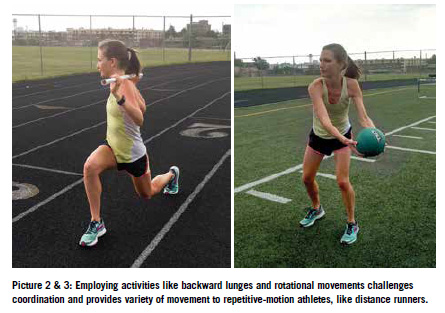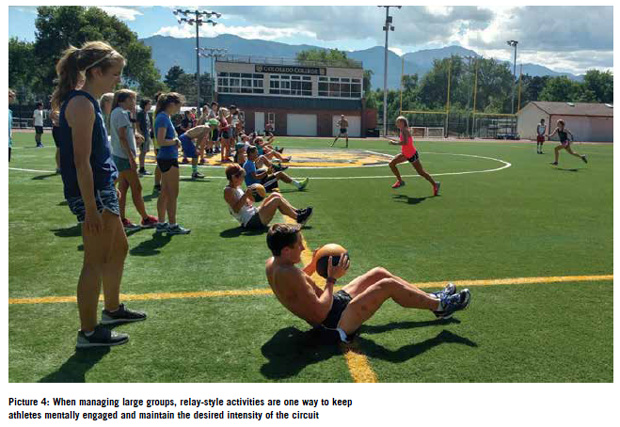| Strength Training for Distance Runners - Versatile Conditioning Improves Balance and Encourages Longevity |
| By: Carrie Lane
Originally Published in: Techniques Magazine Provided by: USTFCCCA Many good distance coaches recognize that a strength training regimen will enhance their athletes' durability, coordination, and therefore efficiency of movement. But where to start? Even if coaches do understand how to interface strength with endurance, they face countless logistical challenges such as managing their team numbers safely, lack of a weight room, and many more. With all the time constraints encountered by high school, collegiate, and post-collegiate distance runners, strength and power sessions can easily fall by the wayside as the season progresses. However, there are numerous ways to keep strength training in the program year-round while navigating these unique challenges. This article will briefly justify why a strength and power program is beneficial for endurance athletes. Then will discuss what are the most important activities for distance runners and how to practically implement these exercises into the busy schedules of distance athletes. For the purposes of this article, the terms "strength training" or "weight training" include: absolute speed work (intense, short sprints with full recovery), medicine ball and bodyweight activities, traditional weight room activities, plyometric training, and sprint development drills.
WHY SHOULD WE LIFT? A consistent strength training program for distance runners will: 1. Improve running economy 2. Provide movement patterns that contrast the repetitive nature of running 3. Accelerate recovery and reduce injury potential REASON #1: IMPROVED RUNNING ECONOMY Simply put, running economy means that a runner gets from point A to point B with as little wasted energy as possible. Less wasted movement means conserving energy and reducing injury susceptibility. Research shows that a major influence on running economy is a runner's ability to apply force off the ground. One, two, three strength training that concentrates on force production skills - namely in the form of low level plyometrics, short sprinting, multi-throws, and traditional Olympic lifting - is an excellent way to teach the force generating skills that improve stride efficiency. These movements demand a level of intensity that, in turn, trains the neuromuscular system to coordinate muscular firing patterns, maintain good posture while under load, change direction efficiently (i.e. "coupling time"), and build a supportive network of soft tissue development. These activities of strength training therefore provide runners with a variety of ways to train the skill that contributes to improved force production with each stride. (See Picture 1) REASON #2: VARIETY OF MOVEMENT Not only does weight training teach valuable movement skills, it also provides opportunity to move in directions, planes, and amplitudes that differ from the repetitive, forward-moving motion of distance running. Variety of movement builds durability throughout the connective tissue in an athlete's body. Picture a volleyball net that is pulled every day in the same direction. Over time, the individual squares of the net become distorted, lines of tension develop through the direction of pull, and perhaps the net begins to sag in certain places. The distortions that develop in the net can be corrected by pulling the net in a completely different direction, perhaps with a few hard tugs. Varying directions and amplitude of pull provide a change or stressor that allows the net to re-align. Similarly, in distance running, soft tissue is constantly "pulled" in one direction, causing strength in commonly used planes and amplitudes, and weakness and strain in less commonly used movement patterns. If the direction and amplitude of stress is altered - like pulling a few hard tugs of the net in a different direction—tissue will strengthen throughout the body, not just where it is most used during running efforts.
In short, strength training can greatly enhance durability throughout runners' soft tissue and joints. (See Pictures 2 & 3) REASON #3: ACCELERATE RECOVERY Employing certain strength training protocols (sets, reps, rest) can complement and enhance the recovery processes for endurance athletes so that they are ready to go on hard workout days. Lifting relatively heavy loads allows distance runners to put more tissue under tension than they do when running at sub maximal paces or performing bodyweight strength exercises. When they tap into those less-used, but very large, muscle fibers, the body responds by releasing hormones that start the recovery and rebuilding process. While lifting heavy provides a contrast in intensity that offers anabolic effects for recovery, other strength training protocols complement the run intensity to also enhance recovery. These protocols usually come in the form of up-tempo body-weight, medicine ball, and simple weight circuits. When performed with proper intensity and time limits, the cumulative effect of the circuits elicits an endocrine response to accelerate recovery. Therefore, following a recovery run with a few light strength circuits will enhance the desired effect for the day. An added bonus of these circuits is that they save some pounding on the legs and provide movement variety patterns to the most commonly used contractions of sub-maximal running. (See Picture 4 on next page) Circuits are where most distance coaches live when it comes to strength training. They present minimal risk of injury when implementing with a group of diverse abilities, with limited time, and limited equipment. When performed properly, they are an excellent complement to recovery runs. WHAT ACTIVITIES SHOULD BE INCLUDED IN STRENGTH TRAINING SESSIONS? When orchestrating running and strength sessions, the paramount goal should be to match the running theme with the strength training theme. Common themes that transfer seamlessly from the running workout to the strength training workout send the body and brain the same clear message. Therefore, on recovery and threshold days, strength training activities should consist of work that enhances recovery, namely in the form of the short, mildly intense circuits described later in this article. On more intense speed development days, strength training can consist of more technically demanding work, such as jumping, throwing, or Olympic and static lifting, which are all activities that help build firing patterns, coordination, posture, and running economy. In short, common themes amongst running and lifting sessions means less busy work and more targeted purpose to every component of training activities.
STRENGTH TRAINING ACTIVITIES TO IMPROVE FORCE PRODUCTION SKILLS The fastest running days provide optimal opportunity for strength training sessions that focus on improving running economy. Here are the types of activities to include on these days: 1. Sprint development drills 2. Hurdle mobility 3. Random "play" 4. Jumping and throwing 5. Fast, short sprinting 6. Olympic lifts and reactive strength exercises 7. Static lifts (multi jointed, heavy resistance exercises) Of course, all of these exercises need not be included in each training session, but these all help to promote the skill of efficient force generation. Large groups or more developmental runners may never advance to Olympic and static lifts. There are many exercises outside of the weight room that closely mimic the loads, velocities, and muscular coordination demands that athletes will encounter while running. Coaches should utilize exercises from the above categories that correlate with the athlete's developmental age, include elements of coupling time (that is, an athlete's ability to change direction quickly), challenge coordination, and strictly adhere to postural control. Since distance runners spend less time on pure speed development, these force production sessions will be more dispersed than their sprinter counterparts, who engage in speed development sessions 2-3 times per week. PROTOCOLS FOR FORCE DEVELOPMENT ACTIVITIES Adhering to the "common theme" rule means it will take longer for distance athletes to train force application activities. However, the grey area is the warmup. The lowest level force production skill training (sprint drills, hurdle mobility, random play) can be implemented daily within a simple ten-minute warmup or cooldown, regardless of the workout theme. What little mileage might be sacrificed to make time for these dynamic movement activities, will pay off in training the athletes' ability to handle the repetitive forces of distance running. (See Picture 5) With regards to random play, these are simple, non-contact games that allow for low level plyometric training and variety of movement. They are a great alternative to a traditional warmup or cooldown and still provide force development education. Games such as knockout in basketball, ultimate Frisbee, light soccer shootouts, or other light contests offer a less structured setting than traditional warmups or cooldowns. A less structured session often re-invigorates athletes and opens them up to learning new skills. Especially in the case of an injured athlete, these "games" allow for brain re-training as the body learns how to move again.
While incorporating a dynamic movement warmup or cooldown is the first step in a strength training program for endurance athletes, the next progression is to properly add multi-jumps, multi-throws, short sprints, and/or traditional weight room activities. These activities are NOT aerobic training, and ample time should be allowed for athletes to rest in between sets. The emphasis is on high quality on each repetition. The number of repetitions performed follows traditional speed/power training, and is generally determined by the point at which technique breaks down. The repetition range for most exercises generally falls somewhere between one and eight reps per exercise, depending on the activity. Force development activities, particularly those not involving the weight room, should be implemented as early as possible in the training cycle and modified for lower level athletes. Inserting intense, power-based movements early in the training cycles, even if drastically modified for ability or time of year, will serve distance runners well as they strive to improve overall movement economy. Waiting to employ these movements until athletes are more developed or until it is "racing" season does not build a proper base for the skill of running fast. Force production activities can and should be included throughout the year, and can be modified to match skill levels and training phases. STRENGTH TRAINING ACTIVITIES TO ACCELERATE RECOVERY Training programs for distance runners employ a heavy dose of sub-maximal running that is designed to improved aerobic fitness and provide oxidative recovery after hard workouts. Strength training can easily "piggy-back" these running workouts and will enhance recovery-based and threshold-pace running sessions. The categories of strength training that help to accelerate recovery include: 1. Bodyweight circuits (these are called "General Strength" in most track and field applications) 2. Medicine ball circuits 3. Bodybuilding circuits These circuits will be the bread and butter of most of strength training efforts in the endurance world, since they match so well with sub-maximal effort running. They are staples of many quality track and field programs, thanks mostly to the early coaching education literature compiled by coaches such as Boo Schexnayder, Dan Pfaff, and others. They are easy to employ with large groups of varying ability. They are also easy to implement outside the weight room and in a short amount of time. BODYWEIGTH AND MEDICINE BALL CIRCUITS Not all circuits are created equal, and this is where many endurance coaches implement less-than-ideal circuit protocols. To gain the desired recovery effect of these circuits, athletes' effort levels needs to be high enough to elicit mild amounts of lactate into the blood, but not too high that they "go lactic" looking like an elephant just jumped on their back. The body responds to mild lactate levels by releasing valuable recovery-oriented hormones. As athletes progress through the circuit, they should be moving with intent through each exercise, maintaining effort somewhere between a too slow "gossip session" and a too intense or too long "death march." For example, 30 seconds of work (bodyweight squats) followed by 15-30 seconds of rest, then followed by another activity (v-sits) with the same work-to-rest combination. Continue with a variety of movements, employing large muscle groups, for 8-12 minutes. Working longer than 40 seconds per exercise bout, or longer than 12 minutes for the entire circuit, will not achieve the proper lactate levels needed to promote recovery. Combine a few of these short circuits together, taking 2-3 minutes of rest after each one. Bodyweight and medicine ball circuits allow for creativity and variety in exercise selection. While there are complex strategies to choosing the types and order of exercises for these circuits, in general, start with the biggest movements in the first circuit (lunges, mountain climbers, v-ups, etc) and progress to circuits focusing on smaller muscle groups (core, planks, barefoot work) next. To provide movement variety and strengthen tissue throughout the body, include a heavy dose of rotational, lateral, diagonal and posterior chain-focused movements within each circuit. WEIGHT ROOM CIRCUITS Weight room activities can also be a complex maze of activities that are difficult to pare down to what is the most efficient use of an athlete's time. A good way to utilize the weight room without doing complex movements, like Olympic lifts and squats, is to put together a circuit of simple, "regional" lifting movements. These are often called "Bodybuilding" or "Regenerative" circuits. These circuits involve simple, non-technical weighted movements, such as lat pulldowns, bicep curls, step ups, weighted sit ups, and others, organized in a way that provides an endocrine-based recovery response. These circuits have also come in to popularity with track and field programs. They offer muscular endurance, variety of movement, and hormonal responses that accelerate recovery. Just like the general strength circuits, the work intervals on these weight circuits should be low enough to allow for moderately high power output on each exercise. The general protocol for a Bodybuilding circuit is 10-12 exercises, 2 x 10 reps per exercise at approximately 75% of maximal effort (meaning the last 1-2 reps should be slightly difficult), with 60-90 seconds rest between each exercise. 9, 11 The specific exercises should address all regions of the body, but the lifts should not be technical in nature. Bodybuilding circuits are fairly simple to organize with a large group, as athletes can partner up and move through each "station" of activities. Grouping athletes at a station will ensure they rest as needed while still getting quality work In short, "Theme is King" when organizing effective and efficient strength programs for distance runners. Matching the fastest running days with the most intense and complex strength training activities will enhance the neuromuscular coordination needed for fast, efficient running. Conversely, matching the sub-maximal threshold, intervals, and easy runs with strength protocols that help accelerate recovery will greatly augment the run training. BUT WE DON'T HAVE.... There are plenty of strength training challenges that distance teams of all ages and abilities encounter. Many coaches argue that their teams are too big to organize productive strength sessions, that they have diverse levels of skills and motivation from their athletes, they don't have facility access, or their assigned strength coach does whatever he or she wants. These and other scenarios are real issues that most distance coaches must work through. Many coaches have figured out creative ways to implement strength/power/speed training without the use of a weight room. For their force production skill work, they employ jumping and all-out, short sprinting (even up a steep set of stairs), both of which require no equipment. They bring medicine balls, sand-filled innertubes, or portable hurdles to the local park where they train. They organize relay-style circuits that foster a competitive environment to keep enthusiasm high. They schedule strength training on different days for different groups of runners. To make time for these activities, a small percentage of overall mileage may be sacrificed. But to foster long-term durability of runners, sacrificing a small percentage of mileage to make time for work that enhances running economy is a sacrifice worth making. In many cases, getting healthy athletes to the line late in the season when competitors may be sidelined with injury, is argument enough for this small mileage sacrifice. Strength training for endurance athletes provides robustness, power, and movement economy to runners of all ability levels. 12 Many endurance coaches are taking pages from the speed/power world and adapting the training concepts for their aerobic athletes. Complementary and contrasting movements provide durability to soft tissue. Force production training as early as possible during a career or a season offers athletes small "hits" of movement economy training throughout the season. And, finally, common "training themes" should provide guidance to coordinate strength sessions that match the theme of the running session. REFERENCES 1. Mann R, Sprague P. A Kinetic Analysis of the Ground Leg During Sprinting, Research Quarterly for Exercise and Sport. 1980. 51;2, pp 334-348. 2. Weyand P, et al. Faster top running speeds are achieved with greater ground forces, not rapid leg movement. J Appl Physiology. 2000. 89, pp 1991-99. 3. Weyand P, et al. Biological limits to running speed are imposed from the ground up. J Appl Physiology. 2010. 108, pp 950-961. 4. Sale D. Neural adaptation to resistance training. Med Sci Sports Exerc. 1988. 20 pp s135-145. 5. Kraemer, W. J., et al. Hormonal and growth factor responses to heavy resistance exercise. J. Appl. Physiol. 1990. 69, pp 1442- 1450. 6. Gladden, L.B. Lactate metabolism: a new paradigm for the third millennium. J Physiol. 2004. 558, pp 5-30. 7. Phillip. A., et al. (2005). Lactate- A signal coordinating cell and system function. The Journal of Experimental Biology. 208, pp 4561-4575. 8. Brooks, G.A. The lactate shuttle during exercise and recovery. Med Sci Sports Exerc. 1986. 18, pp 360-368. 9. Schexnayder, B, et al. TRACK AND FIELD ACADEMY SCC 301 CURRICULUM. 2013. www.ustfccca.org/track-and-fieldacademy 10. Knowles, B (interview). Reconditioning with Bill Knowles. GAINcast episode 49, http://www.hmmrmedia. com/2017/01/gaincast-episode-49-reconditioning- with-bill-knowles/ Jan 26, 2017 11. Kraemer, W. Influence of endocrine system on resistance training adaptation. NSCA Journal. 1992. 14:2, pp 42-45. 12. Balsalobre-Fernández C, Santos- Concejero J, Grivas G V. Effects of strength training on running economy in highly trained runners: A systematic review with meta-analysis of controlled trials. J Strength & Conditioning Research. 2016. 30 (8): 2361-2368. Carrie Lane is an assistant track and field coach at the University of Wyoming. She also serves as a lead instructor in the USTFCCCA Track & Field Academy’s Strength and Conditioning Coach Certification program. |













